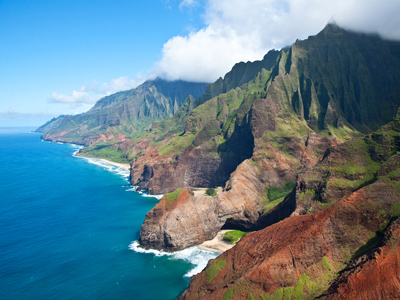
Volcanoes in the Middle of Tectonic Plates
This GCSE Geography quiz will challenge you on volcanoes in the middle of tectonic plates. By now, you will no doubt have learnt that volcanoes occur in narrow belts in certain areas of the world. These belts also suffer earthquakes and they mark out the areas where the Earth's tectonic plates are coming together or moving apart. But there are some volcanoes that occur well away from the edges of the plates. These create natural hazards that are a danger to life when they erupt.
Volcanoes that form away from plate boundaries are created by hotspots. A hotspot is an area in the mantle that is believed to be somewhat hotter than the surrounding material. The rising magma from the hotspot can push its way through the crust and burst out at the surface, forming a volcano.
As the plate moves over a hotspot, it leaves a trail of extinct volcanoes. These can help to show how far and in which direction the plate has moved in the past. Earth scientists still don't understand hotspots very well, there are some theories but nothing has been proved yet.
The usual example of volcanoes of this type are the Hawaiian Islands in the Pacific. These are a chain of volcanic islands and you can clearly see that they have formed in a line. The oldest are to the north west and are no longer volcanically active. The youngest is the biggest, and the only one that has volcanoes. There is a new volcano forming underwater about 35 km from this island, one day, it will grow enough to be above sea level. Measured from the sea bed to their summits, the volcanoes of Hawaii are some of the world's tallest mountains.
Other sites of this type of hotspot volcano are the Galapagos Islands, the Canary Islands and most of the small islands of the south Pacific. They are formed from shield volcanoes. A shield volcano erupts basaltic lava (when it solidifies it forms the igneous rock basalt). This type of lava has a low viscosity (flows easily) and so shield volcanoes have wide bases and gentle slopes. The other basic type of volcano is a composite cone. This has steeper sides and erupts a more viscous lava. Its vent can become blocked which leads to powerful explosions as the pressure builds up. The magma that feeds this type of volcano is said to be acidic and the lava cools to form igneous rocks like andesite and rhyolite.
Hotspot volcanoes occur under continental land masses as well as under oceans. You have probably heard of the Yellowstone supervolcano in the USA. Yellowstone Park lies above a large magma chamber which has erupted several times during the last few million years. A supervolcano releases much larger amounts of material (at least 1000 km3) to a 'normal' volcano. To give you an idea of how big that is, if you dug a hole 1 km wide and 1 km deep, it would need to be 1000 km long to have the same volume as the smallest amount of material erupted from a supervolcano! Supervolcano eruptions from the Yellowstone hotspot can be traced back about sixteen million years and were larger than the well-known Krakatoa eruption in Indonesia. But don't worry, Earth scientists are monitoring it closely and they do not believe that it is likely to erupt any time soon!
Ready for more?
not all...
quizzers. Try to win a coveted spot on our Hall of Fame Page.







